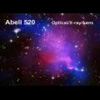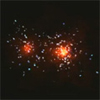CXC Home | Search | Help | Image Use Policy | Latest Images | Privacy | Accessibility | Glossary | Q&A
Images of Galaxy Cluster "Train Wreck"
Quicktime MPEG
This sequence of images of Abell 520 shows the aftermath of a complicated collision of galaxy clusters. Chandra detects multimillion degree gas that pervades the clusters (red). Optical telescopes can be used to infer the location of most of the matter in the cluster - dominated by dark matter - through its effects on distant galaxies (blue). Visible light data also reveal the starlight from the individual galaxies (yellow and orange). The composite image shows the chaotic aftermath of this collision between at least two clusters of galaxies.
[Runtime: 0:13]
(Credit: X-ray: NASA/CXC/UVic./A.Mahdavi et al.; Optical/Lensing: CFHT/UVic./A.Mahdavi et al.)
Quicktime MPEG
This sequence of images of Abell 520 shows the aftermath of a complicated collision of galaxy clusters. Chandra detects multimillion degree gas that pervades the clusters (red). Optical telescopes can be used to infer the location of most of the matter in the cluster - dominated by dark matter - through its effects on distant galaxies (blue). Visible light data also reveal the starlight from the individual galaxies (yellow and orange). The composite image shows the chaotic aftermath of this collision between at least two clusters of galaxies.
[Runtime: 0:13]
(Credit: X-ray: NASA/CXC/UVic./A.Mahdavi et al.; Optical/Lensing: CFHT/UVic./A.Mahdavi et al.)
Animation of Galaxy Cluster
Quicktime MPEG
Galaxy clusters are some of the largest structures in the Universe. They can be comprised of hundreds or even thousands of individual galaxies that are enveloped by hot gas. When these massive structures collide, it can be an incredibly energetic event causing dark matter to separate from 'normal' matter.
[Runtime: 0:38]
Animation: NASA/CXC/A.Hobart
Quicktime MPEG
Galaxy clusters are some of the largest structures in the Universe. They can be comprised of hundreds or even thousands of individual galaxies that are enveloped by hot gas. When these massive structures collide, it can be an incredibly energetic event causing dark matter to separate from 'normal' matter.
[Runtime: 0:38]
Animation: NASA/CXC/A.Hobart
Return to Abell 520 (16 Aug 07)




